How to clean the toilet of limescale: effective chemical and folk remedies
One of the indicators of a well-kept apartment is a clean toilet. Unfortunately, colored spots appear on the walls of any plumbing from time to time. In most cases, we are dealing with a raid of lime, which is difficult to remove.
Agree, changing because of the poor appearance of the toilet is impractical, but using a contaminated closet is unpleasant. There is only one solution to the problem - to choose an effective cleaning agent and to prevent the appearance of old, difficult to remove stains. Not sure how to do this? We will help you understand these issues.
In the article we described the most effective ways to combat pollution, listed how to clean the toilet of limescale, and also gave tips on maintaining cleanliness in the bathroom.
The content of the article:
How is limescale formed?
First, find out where this very raid comes from. Most often, it manifests itself in the form of yellow spots, especially at the place of flushing, gradually settling on the surface of chrome and ceramic products.
There are several reasons for plaque formation. Let's consider them in more detail.
Reason # 1. Water flowing through pipes. It contains minerals (calcium, magnesium), salts, particles of soil - it is they who make the water hard.

Reason number 2. The build-up of lime is facilitated by a faulty flushing tank, which flows continuously, so it is so difficult to get rid of a piled layer. When water enters the plumbing, mineral particles accumulate.
Reason # 3. Non-observance of simple rules of cleanliness in the toilet. For example, if you flush the toilet with insufficient water or forget to do it at all. From here and bad smell, and a yellow coating.
Reason No. 4. Due to the use of metal brushes for cleaning, small cracks and roughness occur on the protective enamel, which covers almost all toilets.It is on them that plaque settles, gradually absorbing into the material of the product. Over time, it becomes impossible to wash such plumbing white.
Reason number 5. Old Soviet toilets have a porous structure and are not coated with enamel, so quite a lot of limescale can accumulate on them.
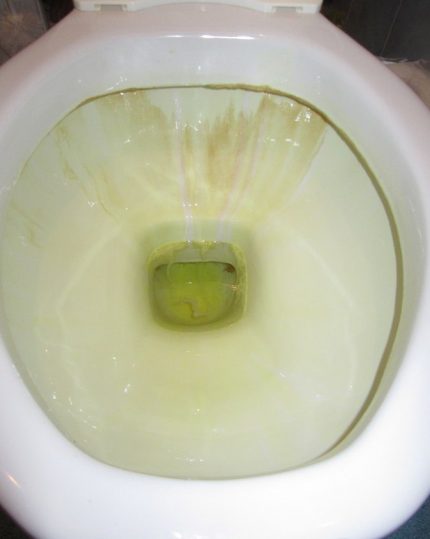
Hot water can also damage the protective layer if it is systematically poured into the toilet. After the purchase and toilet installation, be sure to read the recommendations regarding the rules for caring for him.
These are the main reasons due to which a plaque may appear. And how to dissolve a coating of lime on the walls of the toilet will be discussed further.
Methods for cleaning the toilet
To carry out cleaning, you can use the means at hand. Before using any of them, you must: clean the sewerGet rid of water in contaminated places. To remove stagnant water, use a plunger or a regular plastic cup. And then apply the cleaning agent.
Method number 1 - folk cleaning products
If a raid has just appeared or if you do not want to use chemicals for any reason, then magic folk mixtures will come to the rescue.
Lemon acid. Put a mixture of 2-3 sachets and water on the coating and leave it overnight. Leave the cover closed. Calculate the required amount of acid depending on the degree of contamination. In the morning, rub with a damp cloth or a brush and rinse with plenty of water. If the contamination has not disappeared, then the procedure can be repeated.
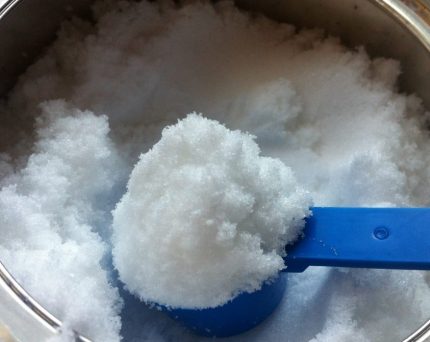
Technical oxalic acid. It was used by our grandmothers and great-grandmothers. Put a little powder (1-2 tablespoons) on a damp soft cloth or immediately on dirt and rub. Repeat, rub again with a brush, but not metal, and rinse.
Vinegar (9%). If you find, then acetic acid is 70%. Be sure to use a protective dressing at all stages of preparation and use of this tool. Heat 250 g of vinegar to 40-45-С.
To enhance the effect, add 2-3 teaspoons of baking soda. Then, pour the resulting mixture into the toilet and cover. Leave it this way for at least 5-6 hours, preferably all night. After that, treat with a brush and a rag, rinse with water.
Baking soda. It significantly increases the effectiveness of other products - vinegar, citric acid. To qualitatively remove plaque, immediately take the whole pack (200 g). Prepare a mixture with water, apply to plumbing and leave it overnight. You can add a few tablespoons of vinegar to the mixture. Then rub and rinse.

Electrolyte for cars. The liquid must be used very carefully, since it contains sulfuric acid. Put on gloves, a mask and glasses beforehand, as even a drop of this product can cause a burn. Apply the substance only on a dry surface while at arm's length.
Close the lid immediately. After 15-20 minutes, but no more than a few times in a row, rinse without opening the lid. Remember that electrolyte must not be used if plastic pipes are connected to the toilet, as acid can damage them.
Since this tool is very toxic, it should be used only as a last resort, when others can not cope with pollution.
Hydrochloric acid. It can be found in plumbing departments or in hardware stores. Use this acid in the same way as electrolyte. Do not forget about precautions.
Coca Cola. This drink comes from the nineties known to everyone. To get rid of plaque, pour 1.5-2 liters of cola into the toilet sink and leave it overnight. Then you need to rub the dirt with a rag and rinse with plenty of water.
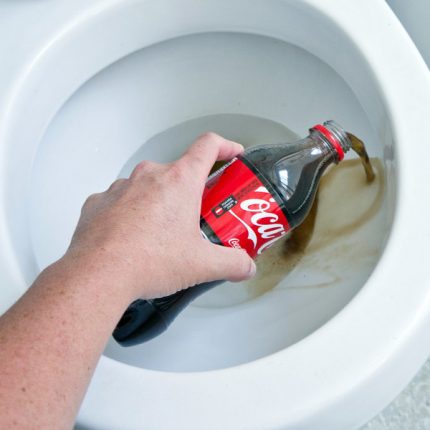
White. Wipe the inside of the toilet and fill it with white. Leave it overnight, then rub the coating with a brush and rinse.
Iodine Monochloride. This liquid can be bought at any veterinary pharmacy. The product must be poured onto a dry surface and rinsed off after a few minutes. Do not leave the product on the surface for longer than 10 minutes, and also can not be used for cast iron or aluminum pipes.
If not a single folk remedy has coped with the problem, then it is time to use household chemicals.
Method number 2 - household chemicals
Today on the shelves of shops there are many chemicals for cleaning toilets. But before using any household chemicals, you must carefully study the instructions.
By composition, all chemicals for cleaning the toilet are divided into: acidic, alkaline and chlorine-based products. Powder products also exist, but they are less popular.
Acid gels and liquids considered one of the best in the fight against settled lime, although they contain a small amount of acid. They should be used with special precautions, protect hands and face. In addition, never over-acid, so as not to damage the enamel.
One of the most popular acid gels is the toilet duck. It is recommended to use it several times in a row. Apply the gel preferably on a dry surface.

Alkaline products less dangerous than acidic. They can be used often, even daily. They are based on sodium, which dissolves plaque in minutes. For example, gels Bref, Santry, Dosya or Domestos.
Any of these products can be used regularly, but it is important to remember that they can only cope with a thin layer of limescale in one cleaning.
Chlorine based products. After their use, the room should be aired. Such cleanings can be done daily, but safety precautions are important. One of the most popular chlorine based formulations is Titanium or Comets.
The latter is available in the form of a gel and powder. It has a pungent smell, so it is advisable to work with it in a mask.
Powder abrasive products. For instance, Flash, Big power. Such chemistry will perfectly cope with plaque of any age. But they should be used infrequently, as for cleaning it is also necessary to use brushes that can damage the enamel.
And the powders themselves literally “strip off” everything unnecessary from the surface of the toilet, therefore they can also violate the integrity of enamel.
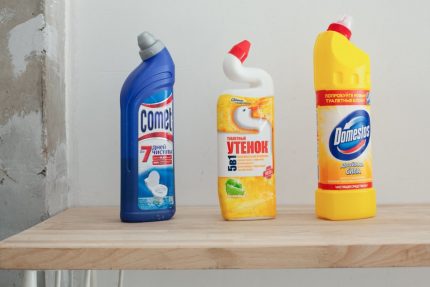
Rules for working with household chemicals
In the pursuit of a clean toilet, it is important not to rush and not to make mistakes.
To do this, follow a few simple rules.
- In order not to provoke damage to the enamel and the stratification of a new coating, never overexpose gels and liquids based on acid.
- After cleaning, rinse off any aggressive cleaning agent with water only with the lid closed so that splashes do not get on the skin.
- To avoid chemical burns to the skin, vapor poisoning or an allergic reaction, try to work with household chemicals in protective gloves and a mask, and also do not lean too far over the treated surface.
- Never use an electrolyte or any other liquid based on sulfuric acid if metal-plastic pipes lead to the toilet.
When cleaning is done and the toilet is shiny, then the question arises: how to prolong this condition and prevent the formation of new pollution?
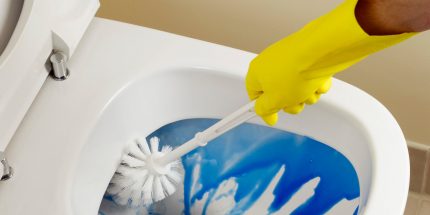
How to keep the toilet clean?
No matter how qualitatively you clean the toilet, there still all the same after a while a new coating layer forms. Therefore, prevention should be carried out as often as possible. We offer some simple preventative measures.
№1. Each time, clean the bowl of any impurities and do not save on water to drain.
№2. Under the rim of the toilet, place a special tool that masks odor, kills germs and plaque.
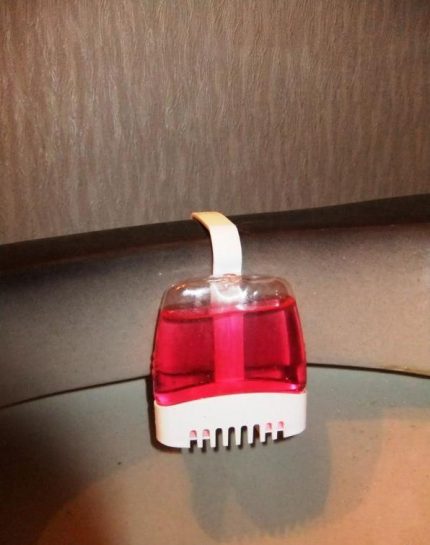
№3. Eliminate flow in a drain tank, because because of her, the coating only overlays. If the leak is left, then after cleaning a new coating will appear very quickly.
№4. If hard water flows through the pipes, then it makes sense to throw special pills into the toilet bowl to reduce stiffness.
№5. Try not to clean the toilet with an iron brush. It leaves small cracks that destroy the enamel and contribute to the accumulation of plaque.
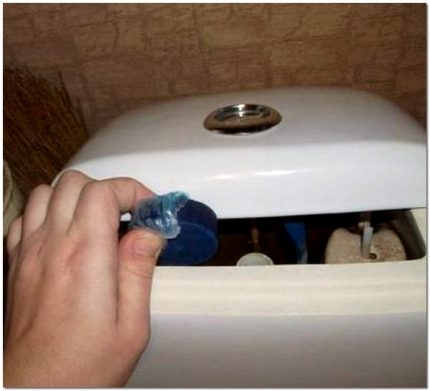
№6. It is advisable to clean the toilet with special tools at least once a week or two, depending on how many people use it. Use only liquid or gel cleaners and soft rags.
№7. Do not pour grease or other food debris, especially hot food, into the toilet.
Observing these simple rules, you can effortlessly maintain a clean toilet. The main thing is not to start the problem and conduct scheduled cleanings on time.
Conclusions and useful video on the topic
For clarity, we suggest watching a few video tips.
The author shows an effective way to clean the walls of the toilet from lime deposits in several stages using improvised means:
Useful tips for those who want to clean the elbow of the toilet from old dirt. Vinegar is used as the main ingredient, and the author also gives useful tips:
It is quite easy to get rid of mineral deposits on the walls of the toilet. Use one of our tips, and then your toilet will shine clean. But remember that prevention is always cheaper than emergency cleaning.
Share with readers your secrets of keeping plumbing clean. Please leave comments, ask questions about the topic of the article and participate in discussions - the feedback form is located below.

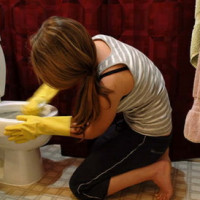 How to clean the toilet from urinary stone, rust and other deposits: the pros and cons of various methods
How to clean the toilet from urinary stone, rust and other deposits: the pros and cons of various methods 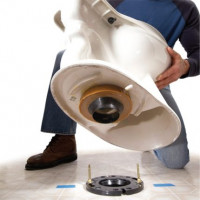 Vertical release toilet: device, pros and cons, installation features
Vertical release toilet: device, pros and cons, installation features 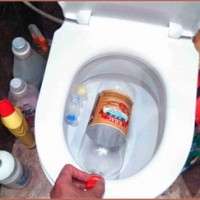 How to clean the toilet with a bottle: step-by-step installation + an overview of alternative methods
How to clean the toilet with a bottle: step-by-step installation + an overview of alternative methods 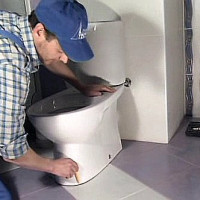 How to install a toilet on a tile with your own hands: step-by-step instruction + installation features
How to install a toilet on a tile with your own hands: step-by-step instruction + installation features 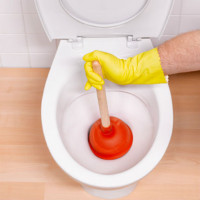 How to clean your toilet yourself: the best ways to eliminate blockages
How to clean your toilet yourself: the best ways to eliminate blockages 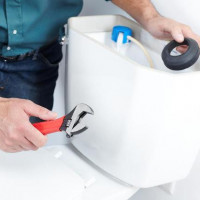 The toilet is leaking after flushing: possible causes of the malfunction and how to eliminate them
The toilet is leaking after flushing: possible causes of the malfunction and how to eliminate them  How much does it cost to connect gas to a private house: the price of organizing gas supply
How much does it cost to connect gas to a private house: the price of organizing gas supply  The best washing machines with dryer: model rating and customer tips
The best washing machines with dryer: model rating and customer tips  What is the color temperature of light and the nuances of choosing the temperature of the lamps to suit your needs
What is the color temperature of light and the nuances of choosing the temperature of the lamps to suit your needs  Replacement of a geyser in an apartment: replacement paperwork + basic norms and requirements
Replacement of a geyser in an apartment: replacement paperwork + basic norms and requirements
After moving to a new apartment, I got a toilet with a touch. As always turned to the good old baking soda. Made a sizzling slurry of soda and 9% vinegar, used almost the entire pack.But! Before applying this slurry, the toilet bowl was treated with Faberlik toilet liquid, without washing it off, it applied soda and left for 6-7 hours. After a little she rubbed with a sponge the hard side, and the plaque was gone. Now, to avoid such unpleasant raids in the future, I wash the tank 2 times a week to drain the water so that dirt and other troubles do not accumulate.
We have very hard water, and to prevent stains from eating, we have to thoroughly clean the toilet every 2-3 days. And since the old Soviet toilet was in a rented apartment, it was already in a sad state. I like the way the toilet duck cleans, but even he cannot clean the old lime stains. I have to turn to acid help, which we pour overnight, this is usually done by the husband, he does not trust me.
We bought a house from the elderly, there all the plumbing was in a sad state. For a long time we suffered with this raid. Santri was able to save the bath, but there is no toilet. Baking soda produced almost no result. Bref was poured overnight, and thoroughly cleaned in the morning. Leaks still remained, but became less noticeable. Perhaps someone knows a proven option, for sure?
Try Harpic, it has never failed me. Even in rather advanced cases, it coped, sometimes the truth is not the first time. Well, if you already try several cleaning products and do not achieve the result, then try the method with battery electrolyte, which is described above in the material. It is very radical, but even if a plaque continues after it, the plumbing will only have to throw it away. Just be extremely careful - be sure to use a respirator, safety glasses and thick rubber gloves. The electrolyte emits sulfuric acid fumes, it is very harmful.